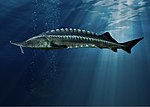Sturgeon
| Sturgeon | |
|---|---|

| |
| Atlantic sturgeon (Acipenser oxyrinchus oxyrinchus) | |
| Scientific classification | |
| Kingdom: | |
| Phylum: | |
| Class: | |
| Order: | |
| Family: | Acipenseridae
|
| Subfamilies | |
Sturgeon is the common name for 28 species of fish in the family Acipenseridae. The family has four extant genera: Acipenser, Huso, Scaphirhynchus, and Pseudoscaphirhynchus. Some species of sturgeon (for example, the beluga), are harvested for their valuable caviar.
Description
[change | change source]Sturgeons are known for their long body, which contains dozens of plates called scutes. They have a sharp snout and a heterocercal tail.
Evolution
[change | change source]Sturgeons have been referred to as "living fossils" or "primitive fish" because their features have not changed very much since their earliest fossil record.[1][2]
History
[change | change source]Acipenseriformes first appeared 174–201 mya. Then, the "true" sturgeons appeared in the Upper Cretaceous.
Taxonomy
[change | change source]Family Acipenseridae (sturgeons)
- Genus Acipenser Linnaeus, 1758
- †Acipenser albertensis Lambe 1902 >
- Acipenser baerii J. F. Brandt, 1869 (Siberian sturgeon)
- Acipenser baerii baicalensis A. M. Nikolskii, 1896 (Baikal sturgeon)
- Acipenser baerii stenorrhynchus A. M. Nikolskii, 1896
- Acipenser brevirostrum Lesueur, 1818 (Shortnose sturgeon)
- Acipenser dabryanus A. H. A. Duméril, 1869 (Yangtze sturgeon)
- †Acipenser cruciferus (Cope 1876)
- †Acipenser eruciferus Cope 1876
- Acipenser fulvescens Rafinesque, 1817 (Lake sturgeon)
- †Acipenser gigantissimus Nessov 1997
- Acipenser gueldenstaedtii J. F. Brandt & Ratzeburg, 1833 (Russian sturgeon)
- Acipenser medirostris Ayres, 1854 (Green sturgeon)
- Acipenser mikadoi Hilgendorf, 1892 (Sakhalin sturgeon)
- †Acipenser molassicus Probst 1882
- Acipenser naccarii Bonaparte, 1836 (Adriatic sturgeon)
- Acipenser nudiventris Lovetsky, 1828 (Fringebarbel sturgeon)
- †Acipenser ornatus Leidy 1873
- Acipenser oxyrinchus Mitchill, 1815
- Acipenser oxyrinchus desotoi Vladykov, 1955 (Gulf sturgeon)
- Acipenser oxyrinchus oxyrinchus Mitchill, 1815 (Atlantic sturgeon)
- Acipenser persicus Borodin, 1897 (Persian sturgeon)
- Acipenser ruthenus Linnaeus, 1758 (Sterlet)
- Acipenser schrenckii J. F. Brandt, 1869 (Japanese sturgeon)
- Acipenser sinensis J. E. Gray, 1835 (Chinese sturgeon)
- Acipenser stellatus Pallas, 1771 (Starry sturgeon)
- Acipenser sturio Linnaeus, 1758 (European sea sturgeon)
- †Acipenser toliapicus Agassiz 1844 ex Woodward 1889
- Acipenser transmontanus J. Richardson, 1836 (White sturgeon)
- †Acipenser tuberculosus Probst 1882
- Genus Huso J. F. Brandt & Ratzeburg, 1833
- Huso dauricus (Georgi, 1775) (kaluga)
- Huso huso (Linnaeus, 1758) (beluga)
- Genus Scaphirhynchus Heckel, 1835
- Scaphirhynchus albus (Forbes & R. E. Richardson, 1905) (Pallid sturgeon)
- Scaphirhynchus platorynchus (Rafinesque, 1820) (Shovelnose sturgeon)
- Scaphirhynchus suttkusi J. D. Williams & Clemmer, 1991 (Alabama sturgeon)
- Genus Pseudoscaphirhynchus Nikolskii, 1900
- Pseudoscaphirhynchus fedtschenkoi (Kessler, 1872) (Syr Darya sturgeon)
- Pseudoscaphirhynchus hermanni (Kessler, 1877) (Dwarf sturgeon)
- Pseudoscaphirhynchus kaufmanni (Kessler, 1877) (Amu Darya sturgeon)

Habitat
[change | change source]Sturgeon range from subtropical to subarctic waters in North America and Eurasia. In North America, they range along the Atlantic coast from the Gulf of Mexico to Newfoundland. They used to be found throughout the Mississippi River, the Great Lakes and the Hudson River.
Throughout this extensive range, almost all species are highly threatened or vulnerable to extinction due to a combination of habitat destruction, overfishing, and pollution.[3]
In the last century, this large fish was often regarded as a nuisance because it often became entangled in and caused commercial fishing nets to become ripped. Only much later did the sturgeon become prized for its meat, eggs (caviar) and oil. Gelatin from the inner lining of its air bladder was used to make isinglass–a substance used as a clarifying agent in jellies, glues and in the isinglass windows of carriages and early cars. Nowadays, the lake sturgeon's dark form can be sometimes be discerned in reedy shallows or near river mouths.
Gallery
[change | change source]


References
[change | change source]- ↑ Chesapeake Bay Field Office. "Atlantic Sturgeon". U.S. Fish & Wildlife Service. Archived from the original on June 15, 2019. Retrieved June 10, 2014.
- ↑ "Lake sturgeon". Minnesota Dept. of Natural Resources. Retrieved June 10, 2014.
- ↑ Sturgeon more critically endangered than any other group of species. IUCN, the International Union for Conservation of Nature. [1]

Other websites
[change | change source]- Acipenser on the FishBase website
- https://www.wikidata.org/wiki/Q181871
